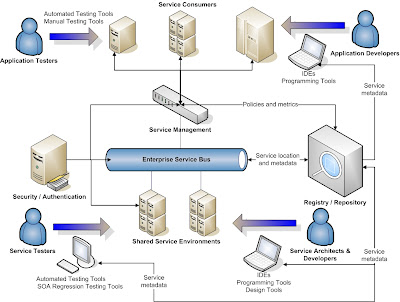
If you refer to the diagram above, you will notice several major components that make up the SOA Ecosystem.
- ESB
- Registry/Repository (RegRep)
- Security
- Service Management
- Shared Service Environments
- Service Consumers
To truly comprehend how the SOA ecosystem operates, a clear understanding must be developed of what each component does and what its role is. Let’s start from the service consumer side.
- Service Consumers
- Application Developers build applications that consume services. They use IDEs and other development tools to construct service requests and parse responses. Developers interact with the Registry/Repository to find the right services, obtain service metadata, and understand usage patterns.
- Application Testers perform quality assurance tasks on the final product.
- Application Servers that execute the application code interact directly with the SOA platform hosting the services.
- SOA Infrastructure
- Service Management Platform acts as an entry point into the SOA infrastructure. It retrieves policy information about the service being executed and applies it appropriately to the request. The policy is used to understand service security and authority, associated SLAs, constraints, contracts, etc. The Service Management Platform is often utilized to keep track of the service consumption and run-time metrics, which are then fed into the Registry/Repository.
- The role of the Enterprise Service Bus has already been discussed.
- Registry/Repository acts as a central repository for services and their metadata. Its uses and integrations are discussed at each related point.
- Security / Authentication Platform is a part of the larger IT infrastructure and is typically represented by either LDAP or Active Directory technology.
- Shared Service Environments are used to host reusable services. While different organizations choose to approach service hosting differently, if a common service hosting platform can be established, many issues related to service scalability, performance, reuse, security, implementation, standardization, etc. can be easily resolved. A centrally managed platform can be easily upgraded to accommodate additional – foreseen or unforeseen – volume. Standard capabilities can be provided to perform security, authentication, logging, monitoring, instrumentation, deployment, and many other tasks.
- Service Creation
- Service Architects and Developers create reusable services using the appropriate design and development tools. They also interact with the Registry/Repository to discover existing services and register new services and related metadata. The created services should ideally be deployed into a Shared Service Environment.
- Service Testers perform quality assurance tasks on the new or modified services. They use special SOA testing tools to create test cases and automate their execution. These tools interface with the Registry/Repository to retrieve metadata about the services and update related information once testing is complete.